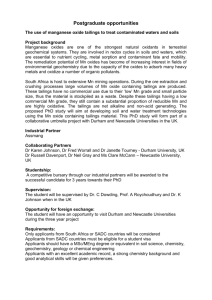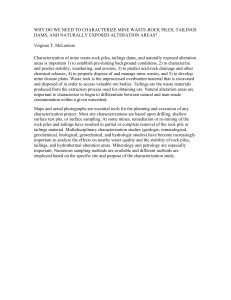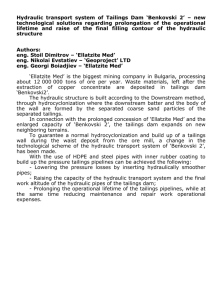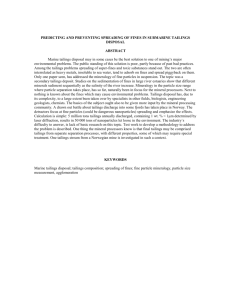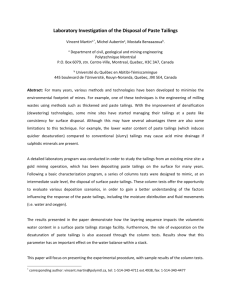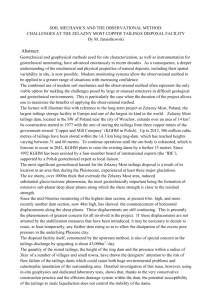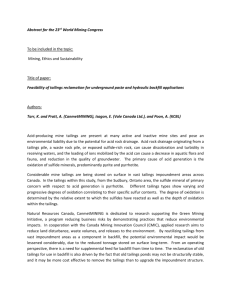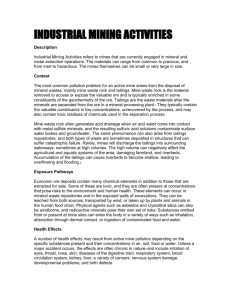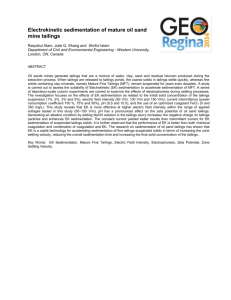278 - Stabilization-Solidification of mixed cement matrix MTE
advertisement
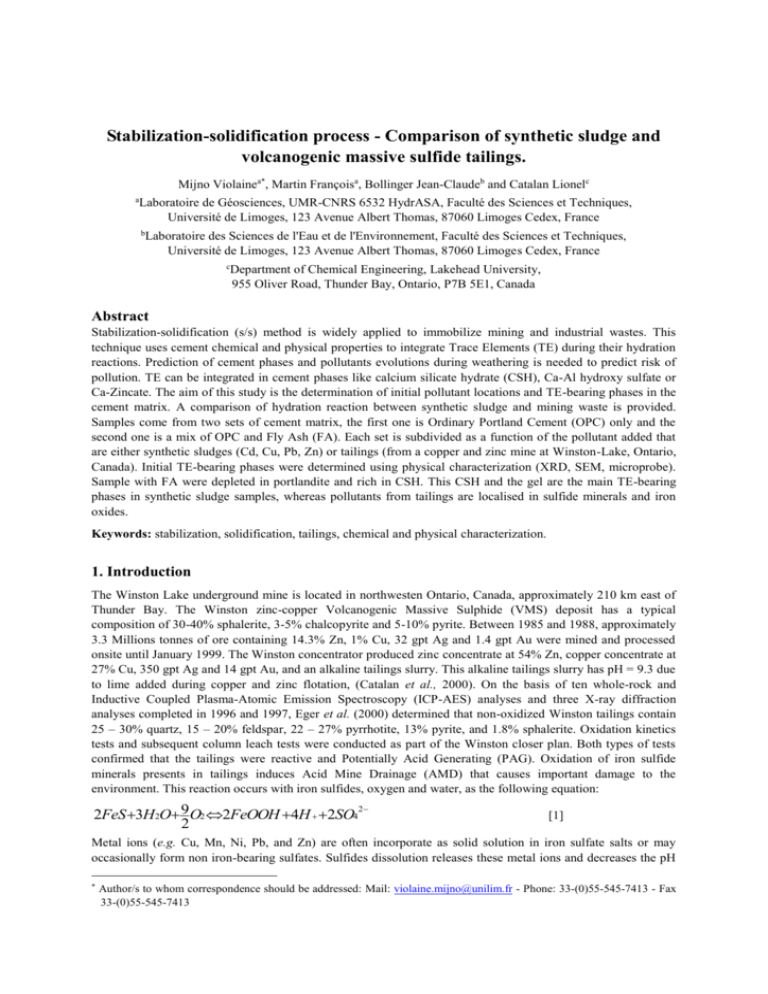
Stabilization-solidification process - Comparison of synthetic sludge and volcanogenic massive sulfide tailings. Mijno Violainea*, Martin Françoisa, Bollinger Jean-Claudeb and Catalan Lionelc a Laboratoire de Géosciences, UMR-CNRS 6532 HydrASA, Faculté des Sciences et Techniques, Université de Limoges, 123 Avenue Albert Thomas, 87060 Limoges Cedex, France b Laboratoire des Sciences de l'Eau et de l'Environnement, Faculté des Sciences et Techniques, Université de Limoges, 123 Avenue Albert Thomas, 87060 Limoges Cedex, France c Department of Chemical Engineering, Lakehead University, 955 Oliver Road, Thunder Bay, Ontario, P7B 5E1, Canada Abstract Stabilization-solidification (s/s) method is widely applied to immobilize mining and industrial wastes. This technique uses cement chemical and physical properties to integrate Trace Elements (TE) during their hydration reactions. Prediction of cement phases and pollutants evolutions during weathering is needed to predict risk of pollution. TE can be integrated in cement phases like calcium silicate hydrate (CSH), Ca-Al hydroxy sulfate or Ca-Zincate. The aim of this study is the determination of initial pollutant locations and TE-bearing phases in the cement matrix. A comparison of hydration reaction between synthetic sludge and mining waste is provided. Samples come from two sets of cement matrix, the first one is Ordinary Portland Cement (OPC) only and the second one is a mix of OPC and Fly Ash (FA). Each set is subdivided as a function of the pollutant added that are either synthetic sludges (Cd, Cu, Pb, Zn) or tailings (from a copper and zinc mine at Winston-Lake, Ontario, Canada). Initial TE-bearing phases were determined using physical characterization (XRD, SEM, microprobe). Sample with FA were depleted in portlandite and rich in CSH. This CSH and the gel are the main TE-bearing phases in synthetic sludge samples, whereas pollutants from tailings are localised in sulfide minerals and iron oxides. Keywords: stabilization, solidification, tailings, chemical and physical characterization. 1. Introduction The Winston Lake underground mine is located in northwesten Ontario, Canada, approximately 210 km east of Thunder Bay. The Winston zinc-copper Volcanogenic Massive Sulphide (VMS) deposit has a typical composition of 30-40% sphalerite, 3-5% chalcopyrite and 5-10% pyrite. Between 1985 and 1988, approximately 3.3 Millions tonnes of ore containing 14.3% Zn, 1% Cu, 32 gpt Ag and 1.4 gpt Au were mined and processed onsite until January 1999. The Winston concentrator produced zinc concentrate at 54% Zn, copper concentrate at 27% Cu, 350 gpt Ag and 14 gpt Au, and an alkaline tailings slurry. This alkaline tailings slurry has pH = 9.3 due to lime added during copper and zinc flotation, (Catalan et al., 2000). On the basis of ten whole-rock and Inductive Coupled Plasma-Atomic Emission Spectroscopy (ICP-AES) analyses and three X-ray diffraction analyses completed in 1996 and 1997, Eger et al. (2000) determined that non-oxidized Winston tailings contain 25 – 30% quartz, 15 – 20% feldspar, 22 – 27% pyrrhotite, 13% pyrite, and 1.8% sphalerite. Oxidation kinetics tests and subsequent column leach tests were conducted as part of the Winston closer plan. Both types of tests confirmed that the tailings were reactive and Potentially Acid Generating (PAG). Oxidation of iron sulfide minerals presents in tailings induces Acid Mine Drainage (AMD) that causes important damage to the environment. This reaction occurs with iron sulfides, oxygen and water, as the following equation: 2FeS 3H2O 9 O2 2FeOOH 4H 2SO4 2 2 [1] Metal ions (e.g. Cu, Mn, Ni, Pb, and Zn) are often incorporate as solid solution in iron sulfate salts or may occasionally form non iron-bearing sulfates. Sulfides dissolution releases these metal ions and decreases the pH * Author/s to whom correspondence should be addressed: Mail: violaine.mijno@unilim.fr - Phone: 33-(0)55-545-7413 - Fax 33-(0)55-545-7413 to acidic condition. Variations of chemical conditions influence metal speciation, and adsorbed metal will be released in solution. Water covers of tailings process is used to limit oxygen diffusion but metal ions are still released (Li et al., 1997; Aubertin et al., 1997). Cement based stabilization/solidification (s/s) processes use cement chemical and physical properties to integrate TE during their hydration reactions. Paste backfill technology developments are stakes to reduce costs associated with backfilling large open stopes or to fill up underground mine, (Benzaazoua et al., 1999). Another attractive aspect is that a large amount of tailings are acid generating and properties of cement (basic pH and high amount of calcium), decrease the risk of AMD. Hydration of cement results in the formation of multiple mineral phases, including portlandite (Ca(OH) 2), Calcium Silicate Hydrate (CSH), ettringite (Ca6Al2(SO4)2.26H2O), and monosulfate ([Ca2(Al,Fe)OH6]2(SO4).xH2O) according to Taylor (1997). When carbon is present calcite (CaCO3) can also forms. Ettringite can immobilize contaminant metals by substitution of Ca 2+, Al3+, and SO42- (Gougar et al., 1996; Albino et al., 1996). Metals can also be incorporated into CSH by sorption, mixing or substitution. X-ray Absorption Fine Structure Spectroscopy (XAFS) and Electron Probe Micro-Analyses (EPMA) provide evidence that incorporation into CSH is the main mode of Zn immobilization when it is added in cement based material as synthetic sludge (Ziegler et al., 2001a and b; Johnson et al,. 1999). Determination of TE-bearing phases in s/s wast will be provided in this study. OPC is the most used cement matrix for s/s process. Mijno et al. (2004), show that portlandite is the first phase to dissolve followed by CSH and Ca-Al hydroxy sulfates. Portlandite is a buffer and release hydroxyls ions during its dissolution reported by Catalan et al. (DATE), and Mijno et al. (2004). Benzaazoua et al. (1999) explain the loss of strength and the increase of porosity by portlandite dissolution. Addition of 25 to 35 wt. % fly ash to OPC in the cement matrix increases strength of materials due to further precipitation of CSH that consumes a part of portlandite according to Benzaazoua et al. (1999) and Conner and Hoeffner (1998). Comparison of cement hydration reaction as a function of the pollutant added has not been completely resolved albeit main chemical models used data provided from synthetic sludge for long term assessment. On the other hand addition of FA in cement matrix decreases portlandite initial amount but CSH precipitation can be dependant of the pollutant. Comparison of s/s waste, with mine tailings and synthetic sludge will be provided with cement matrix set containing OPC or OPC and FA. 2. Materials and Methods 2.1 Sample preparation First set of cement matrix is only OPC whereas the second one consists in FA and OPC with respectively 33.3 wt. % and 66.7 wt.%. Heavy metal sludges were prepared as a solution of 0.1 M Cd(NO 3)2.4H2O, 0.1 M Cu(NO3)2.2.5H2O, 0.1 M Pb(NO3)2, 0.1 M Zn(NO3)2.6H2O and a 6M NaOH solution was added to reach an end point pH of 9.0. Ultra pure water (Barnstread Nanopure Diamond) was used to prepare all solutions. Heavy metals concentrations in the sludge were within the range of concentrations encountered in real wastes that are treated by s/s, EPA/542-R-00-010 (2000) according to Catalan et al. (2002). Weight ratio of synthetic sludge to cement matrix is fixed to 0.4 (Poon et al., 1997; Park, 2000). To be representative of the whole tailings, samples were collected using a soil corer at four different locations. At each location, the depth of oxidation was assessed visually and two composite tailing samples were collected: one corresponds to the oxidized layer and the second one to the reduced layer (50 cm below the oxidized layer). Thickness of the oxidized layer varied with location and ranged from 0.03 and 0.5 cm. Each of the four chosen spots represent 25 wt. % of their respective sample (oxidized or reduced). Oxidized and reduced tailings form two different pollutants. Before being used to prepare samples they were dehydrated using freeze-dryer apparatus, Labconco Freezone 12, during 36 hours at –20°C. Amount of tailings, cement matrix and water was in good agreement with data from Sanchez et al. (2003). Weight percentage of sample and name are reported in table 1. Required amounts of OPC, FA, synthetic sludge, tailings and water were placed in a pre-washed with nitric acid plastic bowl and thoroughly mixed with a plastic spatula. Mixtures were then poured in 5 layers into PVC molds (4 cm diameter × 10 cm height) lined with parafilm. Each layer was rodded with a rounded end plastic tamping rod at a rate of 25 strokes per layer to escape air bubbles formation. Samples were then closed hermetically using a double coat of parafilm and duke-tape for at least twenty-eight days. Table 1: Amount of material used (all in weight %): OPC FA synthetic sludge water Oxidized tailings Reduced tailings S-A S-B S-I S-J S-K S-L 71.4 47.6 23.8 28.6 21.0 14.0 7.0 22.2 14.8 7.4 26.3 52.7 26.3 52.7 22.2 22.6 55.6 55.6 28.6 2.2 Samples analysis Total composition of tailings (oxidized or reduced), OPC and FA were analysed using ICP-AES after microwave digestion using EPA Method 3051 (1994). Thin section were prepared by impregnating tailings or thick slide of s/s waste with epoxy resin and polishing them with a diamonded suspension to obtain a smooth grain section. Observation using an optical microscope (Nikon) was used to ensure that samples were homogeneous in thin section scale and to choose selected zones for Scanning Microscopic Electron (SEM). The thin sections were then carbon-coated for observation with SEM and analysis with microprobe. Morphological and semiquantitative chemical analyses were carried out using SEM. The SEM apparatus is a Philips XL-30 model equipped with an X-ray energy dispersion spectroscopy system (EDS), a backscattered electron (BSE) detector and a secondary electron (SE) detector (accelerating voltage of 20 kV). A CAMECA SX-50 equipped with an EDS system and 4 wavelength dispersive spectrometers (WDS, accelerating voltage of 15 kV, beam current 10 nA, 10s counting time, beam diameter up to 5 µm) was used for the electron microprobe analyses. Standard reference materials used for the electron to calibrate the instrument for qualitative analysis include natural and synthetic silicates, oxides and sulphide minerals. S/s wastes were characterized by X-ray diffraction using a Cu K radiation on a Siemens D5000 diffractometer, equipped with a diffracted-beam graphite monochromator. Prior to XRD analysis, s/s waste samples were finely powdered in an agate mortar, mounted on a powder holder, and the powder surface was smoothed with a glass slide. XRD patterns were carried out in the range of 2° < 2θ < 120° with a 0.04° step and a counting time 15 s per step. The sample d-spacings were compared with data from the Bruker Diffract plus EVA Search/Match Software, Bruker AXS Ltd., Congleton, UK. 3. Results and discussion 3.1 Tailings characterization Tailings have a silty structure granulometry with a size distribution of 59 wt. % > 74 µm and 22 wt. % < 37 µm. Optical observations of tailings phases show orthopyroxenes (enstatite and hypersthene spoiled), quartz, biotite and opaque minerals. ICP-AES data from oxidized and non-oxidized tailings are presented in table 2. Differences in total composition from oxidized and reduced tailings are minor, although oxidized samples seem to contain less iron and sulfur, as expected from AMD. Table 2. ICP-AES analyses from initial material (major elements, Al Ca, Fe, K, Mg, Na, S, and Si are in wt. %, minor elements Cd, Co, Cr, Cu, Mn, Pb, Ti, and Zn are in ppm). Reduced tailings Oxidized tailings Fly Ash OPC Detection limit Al 1.46 1.40 9.22 2.62 2.5E-04 Ca 0.75 0.42 10.17 37.39 1.0E-04 Fe 20.97 16.77 3.32 1.34 5.0E-05 K 0.42 0.37 0.24 0.91 5.0E-04 Mg 1.94 1.76 2.04 1.36 1.0E-04 Na 0.05 0.04 5.66 0.20 1.0E-04 S 11.71 7.97 1.01 1.60 5.0E-04 Si 0.11 0.10 0.26 0.20 2.5E-04 Reduced tailings Oxidized tailings Fly Ash OPC Detection limit Cd 30 14 1 0 1 Co 278 173 12 7 1 Cr 37 37 26 74 1 Cu 1 572 1 019 41 13 1 Mn 289 204 118 308 1 Pb 152 76 33 18 3 Ti 805 763 3 128 1 253 3 Zn 12 276 4 827 57 92 1 Table 3: Amount in ppm of TE in pyroxene, pyrite, sphalerite and iron oxide. pyroxene number of analyses As Cd Cu Pb Zn a 10 Oxidized Tailings pyrite sphalerite (FeS2) (Fe,Zn)S 8 n.d.a 600 ± 5b 50 ± 1 530 ± 1 583 ± 1 4 1 487 ± 2 51 1 043 n.d. 1 756 3 550 n.d. 337 n.d. 266 095 iron oxide pyroxene 5 8 1 243 463 2 385 138 8 485 Reduced Tailings pyrite sphalerite (FeS2) (Fe,Zn)S 7 n.d. n.d. 120 n.d. 1 887 6 94 108 253 n.d. 115 134 716 504 n.d. 369 238 iron oxide 3 500 n.d. n.d. 510 1 130 not detected. b standard deviation Chlorite, jarosite, and goethite were identified with XRD analyses coming from an alteration of pyroxenes and iron sulfides. Opaque minerals (pyrite, sphalerite, and iron oxide) are the main TE-bearing phases but pyroxenes can also integrate copper, zinc and titanium. The average amounts of metal ions (e.g. As, Cd, Cu, Pb, and Zn) in oxidized and reduced tailings are given in table 3. TE in oxidized tailings are associated as following: As with sphalerite, pyrite and iron oxide, Cd with pyroxenes and pyrite, Cu with iron oxides and pyrite, Pb with pyroxenes and iron oxides and Zn with sphalerite ((Zn,Fe)S), iron oxides, pyrite and pyroxenes. TE-bearing phases in reduced tailings are sphalerite, iron oxides for As, sphalerite and pyrite for Cd, sphalerite pyrite and pyroxene for Cu, iron oxide for Pb, and iron oxides and pyroxene for Zn. 3.2 S/s waste characterization Figure 1 shows a Back-Scattered Electron (BSE) image of the sample S-K (oxidized tailings stabilized with only OPC). The main phases were identified to be (a) pyroxene, (b) pyrite, (c) sphalerite, (d) quartz, (e) unhydrated Ca3SiO5, (f) portlandite, and (g) CSH. XRD analyses confirm the presence of all these phases whereas no ettringite was clearly identified. Calcium silicate hydrate coats pyroxene and TE-sulfur. Sample show and homogeneous mix of tailings and cement matrix. Small cracks are present mainly situated in the few unhydrated cement particle. Portlandite is not detected in sample with cement matrix being a mixture of OPC and FA, neither with XRD, optical microscope or microprobe analyses. Portlandite is not detected in samples S-J and SL, OPC and FA compose their cement matrix. BSE f e c b b d a g a Figure 1: Backscattered electron image of unleached S-K sample particle showing (a) pyroxene, (b) pyrite, (c) sphalerite, (d) quartz, (e) unhydrated Ca3SiO5, (f) portlandite, and (g) calcium silicate hydrate. a a g BSE a c e d d b a Figure 2: Backscattered electron image of unleached S-A sample particle showing (a) sulfur TE-bearing phases, (b) gel, (c) portlandite, (d) calcium silicate hydrate, and (e) ettringite. 3.3 Synthetic sludge s/s characterization Figure 2 shows a backscattered electron image of the sample S-A (synthetic sludge and OPC). XRD analyses indicated presence of portlandite, gel, CSH and ettringite. Matrix is well hydrated with only few unhydrated phases and no cracks network. TE-bearing phases were identified as CSH and gel. Respective amount of TE in gel and CSH are 3 778 and 584 ppm of Cd, 1 198 and 1 080 ppm of Cu, 3 778 and 380 ppm of Pb, and 2 895 and 1 892 ppm of Zn. Locally, small (diameter 2µm) TE-bearing phases appear brightly in BSE, they were identified by microprobe analyses as iron sulfur (35.59 wt. % of Fe and 41.63 wt. % of S), with 85 ppm of As, 1 215 ppm of Cd, 1 215 ppm of Cu, 9 563 ppm of Pb and 72 113 ppm of Zn. Comparison of sample S-A and S-B (cement matrix is a mixture of OPC and FA) using XRD analyses, indicates a slightly decrease of portlandite amount. 4. Conclusion During weathering, alteration products of oxidized tailings rich in pyroxene are mainly amorphous iron oxides and chlorite. Iron oxides can incorporate significant levels of different metal ions in the crystal structure (Cornell and Schwertmann, 1996). Main TE-bearing phase are sphalerite for As and Zn, pyroxene for Cd and Pb, and iron oxide for As, Cu and Zn. Iron oxides are stable for pH close to neutral conditions and seem to be a good TEtrapper phase. Influence of dissolution of pyrite and formation of iron oxides in s/s matrix would be used for long-term assessment of this remediation method. The CSH and the gel are the main TE-bearing phases in sample using synthetic sludge. FA addition consuming portlandite to form further CSH is a positive point to stabilized metal ions. Further studies on evolution of these TE-bearing phases during leaching process in batch cells. References Albino V., R. Cioffi, M. Marroccoli, and L. Santoro, 1996, J. Hazard. Mater., 51, 241-252. Aubertin M., J. Dionne, and L. Marches, 1997, Design guidelines and stability criteria if engineering works for water, In Proceeding of the Fourth International Conference on Acid Rock Drainage, May 31-June 6, 1997, Vancouver, British Columbia, Canada, p. 1849-1866. Benzaazoua M., J. Ouellet, S. Servant, P. Newman and R. Verburg, 1999, Cement and Concrete Research, 29, 719-725. Catalan L.J.J., E. Merlière, M. Bliss, 2000, Evaluating of Lime Requirements to Neutralize Pre-Oxidized Sulphidic Mine Tailings Prior to Submergence, to be published. Catalan L.J.J., E. Merlière and C.J. Chezick, 2002, J. Hazard. Mater., B94, 63-88. Conner J.R. and S.L. Hoeffner, 1998, A Critical Review of Stabilization/Solidification Technology, Critical Reviews in Environmental Science and Technology, 28 (4), 397-462. Cornell R.M., and U. Schwertmann, 1996, The Iron Oxides, Structures, Properties, Reactions, occurrence and Uses, VCH, Weiheim, 573 p. Eger P., G. Melchert, D. Anderson, J. Wagner, and J. Folman, 2000, Creating Wetlands on Acid Generating Tailings – Maintenance free Reclamation? Proceedings of the 5th International Conference on Acid Mine Drainage, Denver, Colorado, 21-24 May, Vol. II, 1149-1158 Society for Mining Metallurgy and Exploration Inc. Environmental Protection Agency (EPA), 2000, Solidification/Stabilization Use at Superfund Sites; EPA/542-R-00-010; Office of Solid Waste and Emergency Response, Technology Innovation Office, U.S. EPA: Washington, DC. Environmental Protection Agency (EPA), 1994. Method 3051: Microwave assisted acid digestions of sediments, sludges, and oils. In SW-846 On-line, Tests Methods for Evaluating Solid Waste, Physical/Chemical Methods. Office of Solid Waste, U.S. EPA, Athens, Georgia. Available from http://www.epa.gov/epaoswer/hazwaste/test/main.htm [cited July, 26, 2004]. Gougar M.L.D., B.E. Scheetz and D.M. Roy, 1996, Waste Manage., 16, 295-303. Johnson C.A., and M. Kersten, 1999, Environ. Sci. Technol., 33, 2296-2298. Li M.G., B. Aubé, L. St-Arnaud, 1997, Consideration in the use of shallow water covers for decommissioning reactive tailings, in Proceeding of the Fourth International Conference on Acid Rock Drainage, May 31-June 6, Vancouver, British Columbia, Canada, p. 115-130. Mijno V., L.J.J. Catalan, F. Martin and J.-C. Bollinger, 2004, Journal of Colloid and Interface Science, 280, 465-477. Park C.K., 2000, Cem. Concr. Res., 30, 429-435. Poon C.S., K.W. Lio, 1997, Waste Manage., 17, 15-23. Sanchez F., A.C. Garragrants, C. Vandecasteele, P. Moszkowicz and D.S. Kosson, 2003, J. Hazard. Mater., B96, 229-257. Taylor H.F.W., 1997, Cement Chemistry, Telford, London. Ziegler F., A.M. Scheidegger, C.A. Johnson, R. Dähn and E. Wieland, 2001a, Environ. Sci. Technol., 35, 1550-1555. Ziegler F., R. Gieré and C.A. Johnson, 2001b, Environ. Sci. Technol., 35,4556-4561. Acknowledgements This work was funded by the Regional Council of the Limousin Region (France), and the European Social Funds from the European Community. We wish to acknowledge gratefully the technical and chemical assistance of Michel Peymirat of HydrASA (Limoges, France), Keith Pringnitz and Ain Raitsakas of LUIL (Thunder-Bay, On, Canada).

